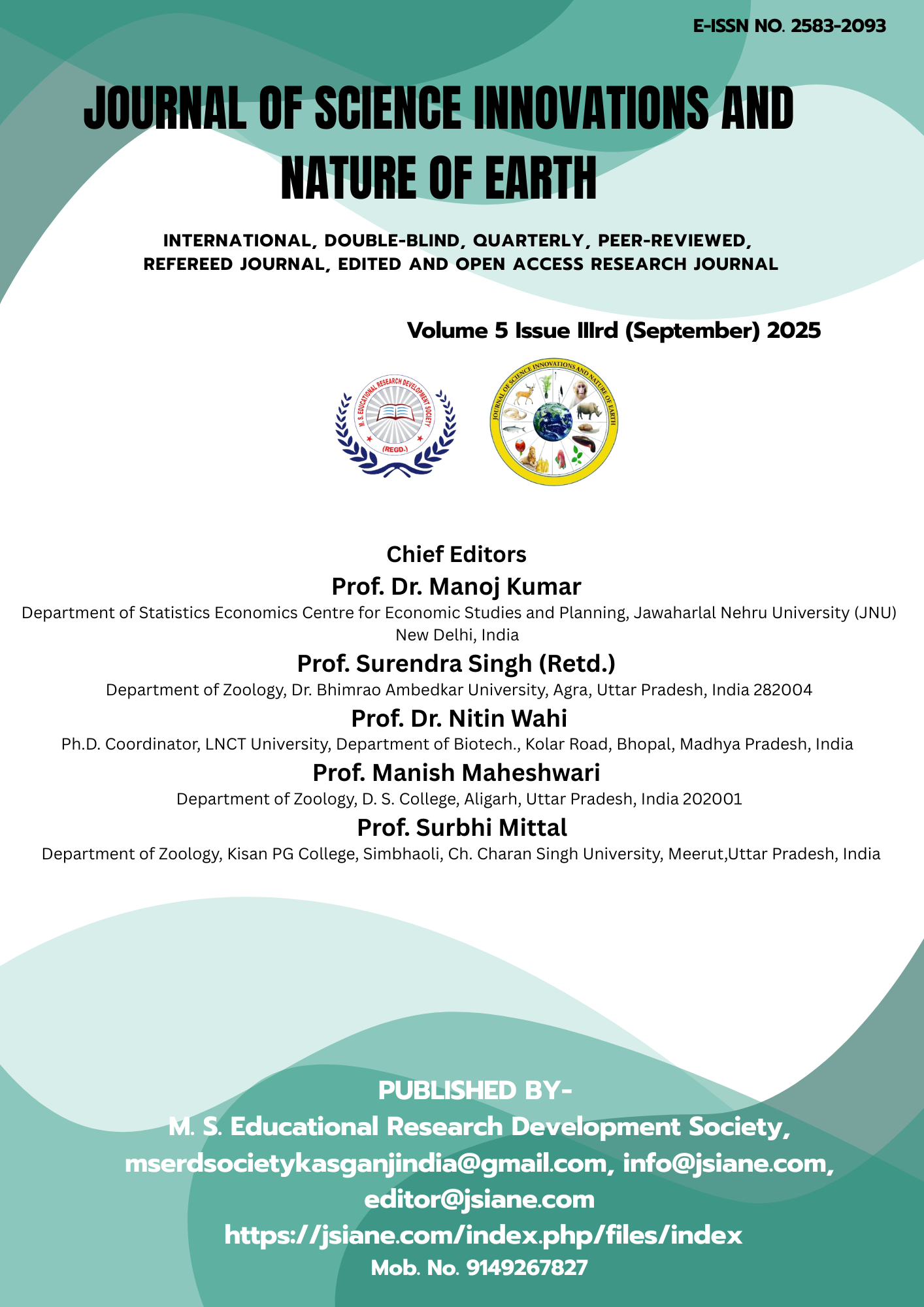SRTM and GIS-Based Geomorphic Analysis of Tons River Basin: A Geographical Case Study
DOI:
https://doi.org/10.59436/jsiane.421.2583-2093Keywords:
Quantitative Approach, Morphometric Analysis, Drainage Pattern, Basin Management, GIS, Tons River BasinAbstract
Tons River Basin is approximately 16,860 sqkm in extent and 264 km in length; It is situated in the Kaimur Range (Upper Vindhyan) at an elevation of 610 meters. The morphometric features were used to conduct a quantitative analysis of the Tons River basin's evolution. Data from SRTM, DEM, and Lands are used to generate the drainage network. Upstream in the drainage basin, the trellis pattern is more prominent, whereas in the middle and downstream, the dendritic pattern is more prevalent. Based on the drainage density, it appears that the basin has a subsurface that is permeable and is covered in dense vegetation. With a smaller drainage area, a larger form factor value indicates a higher flow peak. Results from the Tons River Basin's relief ratio and roughness number show that the soil is easily washed away. According to the results of the present investigation, the Tons River Basin has a low risk of flooding, a low rate of soil erosion, and an abundant supply of surface water. This study has the potential to improve water resource use and pave the way for future growth in the Tons River basin. Finding a connection between the hydrologic characteristics of the basin and morphometric drainage parameters was the goal of these GIS-based studies. Therefore, the present investigation aims to hydrologically characterise the Tons River Basin and quantify its morphometric features (linear, areal, and relief aspects). Basin management, soil and water resource planning, and other related fields can benefit from this helpful data.
References
Agarwal CS (1998) Study of drainage pattern through aerial data in Naugarh area of Varanasi district, U.P. J Indian Soc Remote Sens 26:169–175.
Bhagwat, T.N., Shetty, A. and Hegde, V.S. 2011. Spatial variation in drainage characteristics and geomorphic instantaneous unit hydrograph (GIUH); implications for watershed management- A case study of the Varada River basin, Northern Karnataka. Catena 87: 52–59.
Biswas, S., Sudhakar, S. and Desai, V.R. (1999) Prioritization of Sub-Watersheds Based on Morphometric Analysis of drainage basin: A Remote Sensing and GIS approach, Journal of Indian Society of Remote Sensing, 27(3), pp 155-166.
Chorley, R.J., Donald, E.G., E.G. Malm, P.H.A. (1957) “New standard for estimating drainage Basin Shape” American Journal of Science 255: 138-141.
Clarke JI (1996) Morphometry from Maps. Essays in geomorphology. Elsevier publication. Co., New York, pp 235–274.
Horton, R. E.1932. Drainage basin characteristics, Trans. Am. Geophys. Unon.13: pp 350-361.
Horton, R.E. 1945. Erosional development of streams and their drainage basins; Hydro physical approach to quantitative morphology. Bulletin of Geological Society of America, 56, 275-370.
Javed, A., Khanday, M.Y. and Rias, S. (2011) Watershed Prioritization Using Morphometric and Land Use/Land Cove Parameters: A Remote Sensing and GIS Based Approach. Journal Geological Society of India, 78, 63-75.
Kanth, T.A., Hassan, Z.U. (2012) Morphometric analysis and prioritization of watersheds for soil and water resource management in Wular Catchment using Geo-Spatial Tools” International Journal of Geology, Earth and Environmental Sciences 2: 30-41. 2012
Miller, V.C., 1953. A quantitative study of drainage basin characteristics in the mountain area. Virginia and Tennessee. Technical report. Office of Naval research, Department of Geology, Columbia University, New York.
Nag, S.K. (1968) Morphometric analysis using remote sensing techniques in the Chaka subbasin Purulia district, West Bengal” Journal of Indian Society of Remote Sensing 26, 69–76.
Nautiyal, M. D., 1994. Morphometric analysis of a drainage basin, District Dehradun, Uttar Pradesh. J. Indian Soc. Remote Sens. 22, 251-261.
Nookaratnam, K., Srivastava, Y.K., Venkateswarao, V., Amminedu, E., Murthy, K.S.R. (2005) Check dam positioning by prioritization of micro-watersheds using SYI model and morphometric analysis-remote sensing and GIS perspective” Journal of the Indian Society of Remote Sensing 33 (1), 25–38.
Patel, D., Gajjar, C. and Srivastava, P. (2013) Prioritization of Malesari Mini-Watersheds through Morphometric Analysis: A Remote Sensing and GIS Perspective. Environmental Earth Sciences, 69, 2643-2656.
Schumn, S.A., 1956. Evolution of drainage systems and slopes in badlands at Perth, Amboy, New Jersey. Geological Society of America, Bulletin. 67, 597–646.
Singh, S., Singh, M.C. (1997) Morphometric analysis of Kanhar river basin. National Geographical” J. India, 43 (1):31-43. 1997.
Strahler, A. N. (1964). Quantitative geomorphology of drainage basins and channel networks. In: Chow V.T. (ed.), Handbook of Applied Hydrology. McGraw Hill Book Company, New York Thornbury, W.D. 1969. Principles of Geomorphology. 2nd edition, Wiley and Sons, New York, USA.
Strahler, A., 1957. Quantitative analysis of watershed geomorphology. Transaction AGU 38, 913–920 Vijith, H., Satheesh, R. GIS based morphometric analysis of two major upland subwatersheds of Meenachil river in Kerala. Journal of Indian Society of Remote Sensing, 2006, Vol.34, No. 2. pp.181- 185.
Zavoiance, I. 1985. Morphometry of drainage basins (Developments in water science), Elsevier Science, New York, USA.

Downloads
Published
Issue
Section
License
Copyright (c) 2025 Maharaj Singh Educational Research Development Society

This work is licensed under a Creative Commons Attribution-NonCommercial 4.0 International License.









